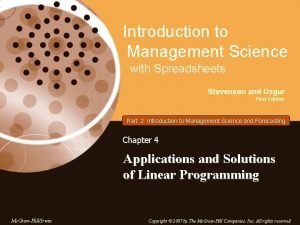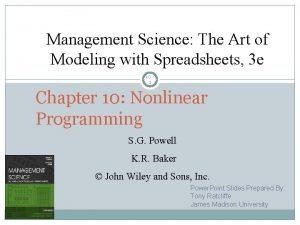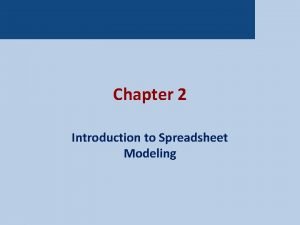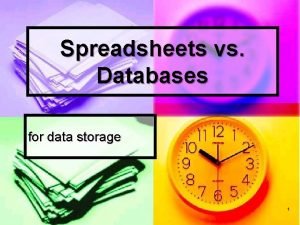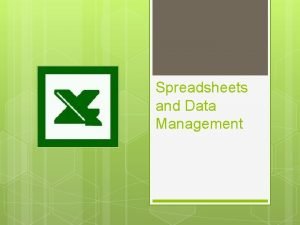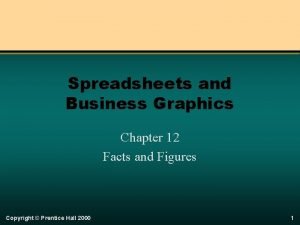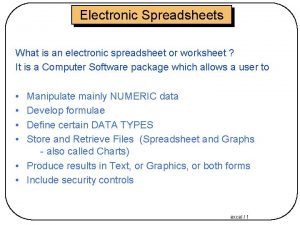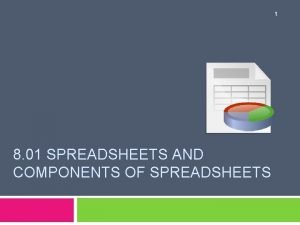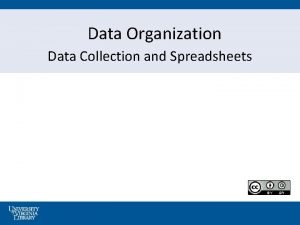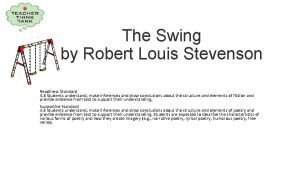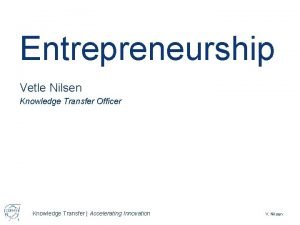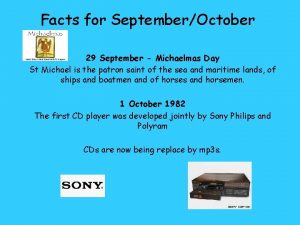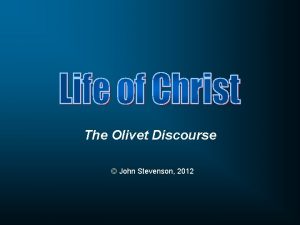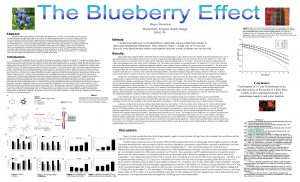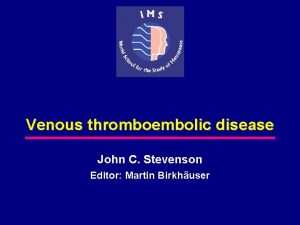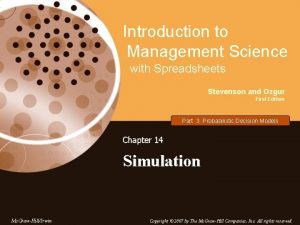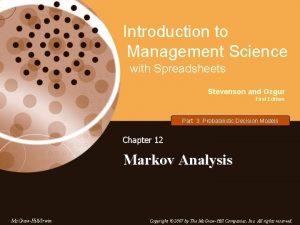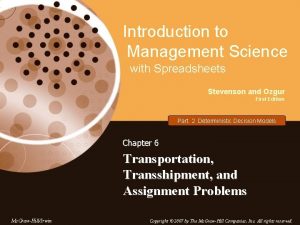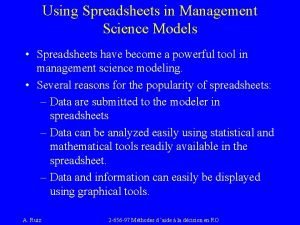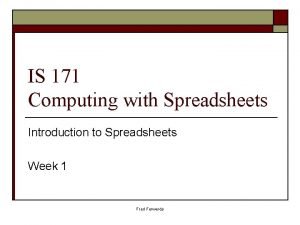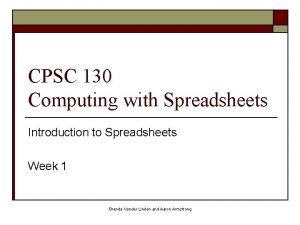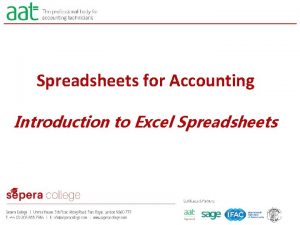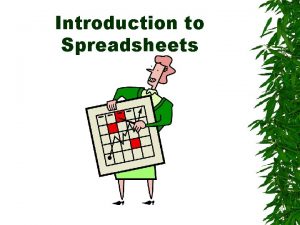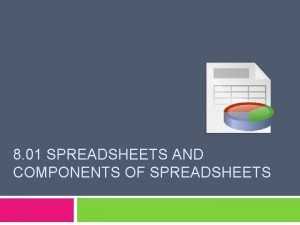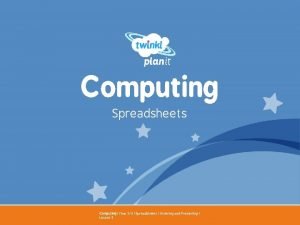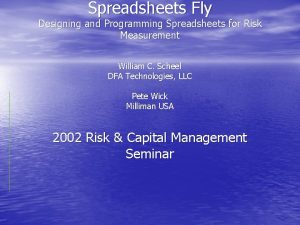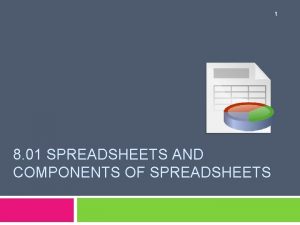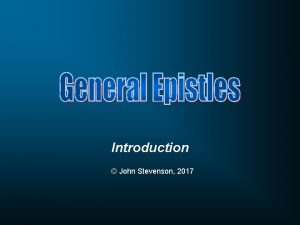Introduction to Management Science with Spreadsheets Stevenson and






































- Slides: 38

Introduction to Management Science with Spreadsheets Stevenson and Ozgur First Edition Part 2 Deterministic Decision Models Chapter 5 Linear Programming: Sensitivity Analysis and Duality Mc. Graw-Hill/Irwin Copyright © 2007 by The Mc. Graw-Hill Companies, Inc. All rights reserved.

Learning Objectives After completing this chapter, you should be able to: 1. Explain how sensitivity analysis can be useful to a decision maker. 2. Explain why it can be useful for a decision maker to extend the analysis of a linear programming problem beyond determination of the optimal solution. 3. Explain how to analyze graphically and interpret the impact of a change in the value of the objective function coefficient. 4. Explain how to graphically analyze and interpret the impact of a change in the right-hand-side value of a constraint. Copyright © 2007 The Mc. Graw-Hill Companies. All rights reserved. Mc. Graw-Hill/Irwin 5– 2

Learning Objectives (cont’d) After completing this chapter, you should be able to: 6. Explain what a dual is. 7. Formulate the dual of a problem. 8. Read and interpret the solution to a dual problem and relate the dual solution to the primal solution. 9. Explain in economic terms the interpretation of dual variables and the dual solution. 10. Determine if adding another variable to a problem will change the optimal solution mix of the original problem. Copyright © 2007 The Mc. Graw-Hill Companies. All rights reserved. Mc. Graw-Hill/Irwin 5– 3

Sensitivity Analysis • Benefits of sensitivity analysis – Enables the decision maker to determine how a change in one of the values of a model will impact the optimal solution and the optimal value of the objective function while holding all other parameters constant. – Provides the decision maker with greater insight about the sensitivity of the optimal solution to changes in various parameters of a problem. – Permits quick examination of changes due to improved information relating to a problem or because of the desire to know the potential impact of changes that are contemplated. Copyright © 2007 The Mc. Graw-Hill Companies. All rights reserved. Mc. Graw-Hill/Irwin 5– 4

Changes in Parameter Values • Categories of model parameters subject to potential changes – The value of an objective function coefficient – The right-hand side (RHS) value of a constraint – A coefficient of a constraint • Concerns about ranges of changes – Which range pertains to a given situation? – How can the range be determined? – What impact on the optimal solution does a change that is within the range have? Copyright © 2007 The Mc. Graw-Hill Companies. All rights reserved. Mc. Graw-Hill/Irwin 5– 5

Optimality and the Objective Function Coefficient • Range of optimality – Finding the range of objective function values for which the optimal values of the decision variables would not change. – A value of the objective function that falls within the range of optimality will not change the optimal solution, although the optimal value of the objective function will change. Copyright © 2007 The Mc. Graw-Hill Companies. All rights reserved. Mc. Graw-Hill/Irwin 5– 6

Feasibility • Range of feasibility – The range of values over which the right-hand-side (RHS) value can change without causing the shadow price to change. – Within this range of feasibility, the same decision variables will remain optimal, although their values and the optimal value of the objective function will change. – Analysis of RHS changes begins with determination of a constraint’s shadow price in the optimal solution. Copyright © 2007 The Mc. Graw-Hill Companies. All rights reserved. Mc. Graw-Hill/Irwin 5– 7

Figure 5– 1 A Graph of the Server Problem Copyright © 2007 The Mc. Graw-Hill Companies. All rights reserved. Mc. Graw-Hill/Irwin 5– 8

Figure 5– 2 Graphical Representation of a Change in the Objective Function Coefficients Copyright © 2007 The Mc. Graw-Hill Companies. All rights reserved. Mc. Graw-Hill/Irwin 5– 9

Example 5 -1 Copyright © 2007 The Mc. Graw-Hill Companies. All rights reserved. Mc. Graw-Hill/Irwin 5– 10

Figure 5– 3 Solution for Revised Server Problem Copyright © 2007 The Mc. Graw-Hill Companies. All rights reserved. Mc. Graw-Hill/Irwin 5– 11

Example 5 -2 Copyright © 2007 The Mc. Graw-Hill Companies. All rights reserved. Mc. Graw-Hill/Irwin 5– 12

Figure 5– 4 The Upper Limit on Using Additional Inspection Time Copyright © 2007 The Mc. Graw-Hill Companies. All rights reserved. Mc. Graw-Hill/Irwin 5– 13

Figure 5– 5 The Lower Limit on Inspection Time Copyright © 2007 The Mc. Graw-Hill Companies. All rights reserved. Mc. Graw-Hill/Irwin 5– 14

Figure 5– 6 Range of Feasibility for Changes in Inspection Time Copyright © 2007 The Mc. Graw-Hill Companies. All rights reserved. Mc. Graw-Hill/Irwin 5– 15

Example 5 -2 (cont’d) Copyright © 2007 The Mc. Graw-Hill Companies. All rights reserved. Mc. Graw-Hill/Irwin 5– 16

Figure 5– 7 Range of Feasibility for the Storage Constraint Copyright © 2007 The Mc. Graw-Hill Companies. All rights reserved. Mc. Graw-Hill/Irwin 5– 17

Exhibit 5 -1 Excel Input Screen for the Server Problem Copyright © 2007 The Mc. Graw-Hill Companies. All rights reserved. Mc. Graw-Hill/Irwin 5– 18

Exhibit 5 -2 Solver Input Specification (parameter) Screen Copyright © 2007 The Mc. Graw-Hill Companies. All rights reserved. Mc. Graw-Hill/Irwin 5– 19

Exhibit 5– 3 Optimization Output Screen Copyright © 2007 The Mc. Graw-Hill Companies. All rights reserved. Mc. Graw-Hill/Irwin 5– 20

Exhibit 5– 4 Excel Basic Output (Answer) Report for the Server Problem Copyright © 2007 The Mc. Graw-Hill Companies. All rights reserved. Mc. Graw-Hill/Irwin 5– 21

Exhibit 5– 5 Excel Sensitivity Analysis Report for the Server Problem Copyright © 2007 The Mc. Graw-Hill Companies. All rights reserved. Mc. Graw-Hill/Irwin 5– 22

Example 5 -3 Copyright © 2007 The Mc. Graw-Hill Companies. All rights reserved. Mc. Graw-Hill/Irwin 5– 23

Example 5 -3 (cont’d) Copyright © 2007 The Mc. Graw-Hill Companies. All rights reserved. Mc. Graw-Hill/Irwin 5– 24

Table 5– 1 Summary of Results of Changes That Are within Ranges of Optimality and Feasibility Copyright © 2007 The Mc. Graw-Hill Companies. All rights reserved. Mc. Graw-Hill/Irwin 5– 25

Duality • The Dual – An alternate formulation of a linear programming problem as either the original problem or its mirror image, the dual, which can be solved to obtain the optimal solution. – Its variables have a different economic interpretation than the original formulation of the linear programming problem (the primal). – It can be easily used to determine if the addition of another variable to a problem will change the optimal. Copyright © 2007 The Mc. Graw-Hill Companies. All rights reserved. Mc. Graw-Hill/Irwin 5– 26

Formulation of a Dual • Dual – The number of decision variables in the primal is equal to the number of constraints in the dual. – The number of decision variables in the dual is equal to the number of constraints in the primal. – Since it is computationally easier to solve problems with less constraints in comparison to solving problems with less variables, the dual gives us the flexibility to choose which problem to solve. Copyright © 2007 The Mc. Graw-Hill Companies. All rights reserved. Mc. Graw-Hill/Irwin 5– 27

Example 5 -4 A comparison of these two versions of the problem will reveal why the dual might be termed the “mirror image” of the primal. Table 5 -2 shows how the primal problem is transformed into its dual. We can see in Table 5 -2 that the original objective was to minimize, whereas the objective of the dual is to maximize. In addition, the coefficients of the primal’s objective function become the right-handside values for the dual’s constraints, whereas the primal’s right-hand side values become the coefficients of the dual’s objective function. Copyright © 2007 The Mc. Graw-Hill Companies. All rights reserved. Mc. Graw-Hill/Irwin 5– 28

Table 5– 2 Transforming the Primal into Its Dual Copyright © 2007 The Mc. Graw-Hill Companies. All rights reserved. Mc. Graw-Hill/Irwin 5– 29

Example 5 -5 Copyright © 2007 The Mc. Graw-Hill Companies. All rights reserved. Mc. Graw-Hill/Irwin 5– 30

Economic Interpretation of The Dual • Economic interpretation of dual solution results – Analysis enables a manager to evaluate the potential impact of a new product. – Analysis can determine the marginal values of resources (i. e. , constraints) to determine how much profit one unit of each resource is equivalent to. – Analysis helps the manager to decide which of several alternative uses of resources is the most profitable. Copyright © 2007 The Mc. Graw-Hill Companies. All rights reserved. Mc. Graw-Hill/Irwin 5– 31

Example 5 -7 Copyright © 2007 The Mc. Graw-Hill Companies. All rights reserved. Mc. Graw-Hill/Irwin 5– 32

Exhibit 5– 6 Excel Worksheet for Arc Manufacturing Inc. Copyright © 2007 The Mc. Graw-Hill Companies. All rights reserved. Mc. Graw-Hill/Irwin 5– 33

Exhibit 5– 7 Excel Basic Output Report for Arc Manufacturing Inc. Copyright © 2007 The Mc. Graw-Hill Companies. All rights reserved. Mc. Graw-Hill/Irwin 5– 34

Exhibit 5– 8 Excel Sensitivity Analysis for Arc Manufacturing Inc. Copyright © 2007 The Mc. Graw-Hill Companies. All rights reserved. Mc. Graw-Hill/Irwin 5– 35

Exhibit 5– 9 Excel Sensitivity Report for Solved Problem 3 Copyright © 2007 The Mc. Graw-Hill Companies. All rights reserved. Mc. Graw-Hill/Irwin 5– 36

Table 5– 3 Excel Reports for Problem 14 Copyright © 2007 The Mc. Graw-Hill Companies. All rights reserved. Mc. Graw-Hill/Irwin 5– 37

Table 5– 3 Excel Reports for Problem 14 (cont’d) Copyright © 2007 The Mc. Graw-Hill Companies. All rights reserved. Mc. Graw-Hill/Irwin 5– 38
 Introduction to management science with spreadsheets
Introduction to management science with spreadsheets Management science the art of modeling with spreadsheets
Management science the art of modeling with spreadsheets What are spreadsheet models
What are spreadsheet models Spreadsheets vs database
Spreadsheets vs database Spreadsheets
Spreadsheets Facts about spreadsheets
Facts about spreadsheets Concept of electronic spreadsheet
Concept of electronic spreadsheet Spreadsheet uses
Spreadsheet uses A collection of spreadsheets
A collection of spreadsheets Science fusion think central
Science fusion think central My favorite subject is
My favorite subject is Stevenson and black 2007 inclusion spectrum
Stevenson and black 2007 inclusion spectrum Zechariah stevenson update
Zechariah stevenson update Zechariah stevenson update
Zechariah stevenson update Robert louis stevenson victorian era
Robert louis stevenson victorian era Till i can see so wide
Till i can see so wide Perfusion tisular
Perfusion tisular Tort and contract difference
Tort and contract difference Howard h stevenson
Howard h stevenson Donoghue v stevenson case summary
Donoghue v stevenson case summary Donoghue v stevenson case summary
Donoghue v stevenson case summary Zechariah stevenson
Zechariah stevenson Zechariah stevenson
Zechariah stevenson Zechariah stevenson sentenced
Zechariah stevenson sentenced Building a life howard stevenson
Building a life howard stevenson Ilona stevenson
Ilona stevenson Dr matthew stevenson
Dr matthew stevenson Valerie stevenson
Valerie stevenson Dr john stevenson
Dr john stevenson Peter stevenson compassion in world farming
Peter stevenson compassion in world farming What is the difference between weather and climate
What is the difference between weather and climate Maeve stevenson
Maeve stevenson Short child occupational profile (scope)
Short child occupational profile (scope) Maeve stevenson
Maeve stevenson Rowland v stevenson
Rowland v stevenson Dr john stevenson
Dr john stevenson Automated protein crystallization
Automated protein crystallization John stevenson syndrome
John stevenson syndrome Open skies apush
Open skies apush
